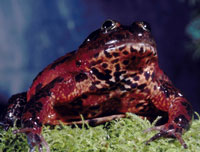A report titled “State of the Frog,” showcases the progress made since the 2008 Year of the Frog campaign began.
 |
Amphibian conservation programs are making headway according to an Association of Zoos and Aquariums report. Titled “State of the Frog,” it showcases the progress zoos and aquariums have made since the 2008 Year of the Frog campaign began in February 2008.
Among the highlights, the Memphis Zoo used in vitro fertilization to breed critically endangered Mississippi gopher frogs (Rana sevosa) in February 2008. A zoo spokesman said it was the first captive breeding the frogs, but the tadpoles died.
Other facilities touted wild-reintroduction accomplishments. Zoos in Washington and Oregon raised Oregon spotted frog (Rana pretiosa) juveniles from egg masses, and Washington wildlife officials released them in Pierce County, Wash., this past fall. On the other side of the U.S., Oglebay Resort’s Good Zoo in Wheeling, W.Va., is helping to develop husbandry techniques for eastern hellbender (Cryptobranchus a. alleganiensis) larvae. Most of these salamanders will be reintroduced to West Virginia streams.
The 2008 Year of the Frog campaign also has helped the endangered mountain yellow-legged frog (Rana muscosa). According to the U.S. Geological Survey, the campaign has elevated awareness, created new funding opportunities and gathered new volunteers for the frog’s recovery program in California.
“AZA is proud of the rapid and significant response of AZA-accredited zoos and aquariums to save frogs, toads and salamanders,” said AZA President and CEO Jim Maddy. “There is much more work to be done, and it will take many years, but these success stories attest to the key role that zoos and aquariums play in amphibian conservation.”




